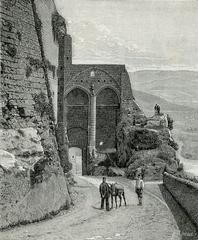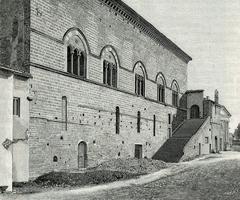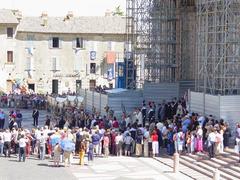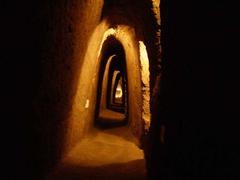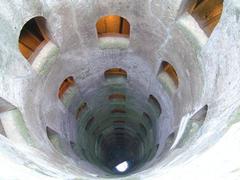Fanum Voltumnae Visiting Hours, Tickets, and Historical Significance in Orvieto, Italy
Date: 15/06/2025
Introduction
Perched atop the volcanic tufa cliffs on the outskirts of Orvieto, in the heart of Umbria, lies the Fanum Voltumnae—one of the most important sacred and political sites of pre-Roman Italy. Revered as the federal sanctuary and assembly place of the ancient Etruscan League, this monumental complex was the focal point for religious rites, political deliberations, and annual gatherings of the Etruscan city-states. The Fanum Voltumnae served as the spiritual and political “omphalos” (navel) of Etruria from as early as the 9th century BCE through the Renaissance (Invitation to Tuscany; World Archaeology).
Ongoing excavations at Campo della Fiera have brought to light temple foundations, monumental altars, sacred roads, and a rich array of votive offerings, affirming Orvieto’s connection to the sanctuary despite centuries of scholarly debate (Archeomedia; RaiNews). Today, visitors can immerse themselves in this ancient heritage through museum exhibits, guided tours, and special events, even as access to the active excavation area remains limited due to preservation efforts (Orvietoviva).
This guide provides a thorough exploration of the Fanum Voltumnae’s history and significance, as well as up-to-date details on visiting hours, tickets, accessibility, travel tips, and suggestions for experiencing Orvieto’s historical landscape.
Table of Contents
- Introduction
- Etruscan Civilization: Origins and Development
- Fanum Voltumnae: Religious and Political Center
- Archaeological Discoveries and Research
- Visiting Information
- Orvieto: Museums and Nearby Attractions
- FAQs
- Planning Your Visit
- Key Facts
- Sources and Further Reading
Etruscan Civilization: Origins and Development
The Etruscans flourished from the 9th to the 3rd centuries BCE, inhabiting Etruria (modern-day Tuscany, northern Lazio, and Umbria). Their society was organized into independent city-states known as lucumonies. Orvieto—ancient Velzna—was one of the most prominent of these, and is widely believed to have hosted the Fanum Voltumnae, the federal sanctuary where religious, diplomatic, and military decisions were made (Invitation to Tuscany; World Archaeology).
Fanum Voltumnae: Religious and Political Center
The Fanum Voltumnae was dedicated to the god Voltumna, a chief deity associated with fertility, fate, and the natural world. Each year, representatives from the twelve Etruscan cities gathered at the sanctuary for religious ceremonies, oracular consultations, feasting, and the election of the federal priest. These meetings were crucial for forging alliances, managing conflicts, and maintaining Etruscan identity (Tages.eu; Britannica).
Archaeological Discoveries and Research
Rediscovery and Site Identification
For centuries, scholars debated the sanctuary’s location. Excavations at Campo della Fiera, led by Prof. Simonetta Stopponi, have confirmed the presence of monumental Etruscan structures, sacred roads, and extensive votive deposits, supporting Orvieto as the site of the Fanum Voltumnae (Archeomedia; RaiNews).
Stratigraphy and Multiperiod Use
The sanctuary’s layers reveal continuous use from the Archaic Etruscan period through Roman, medieval, and Renaissance times. This multiperiod occupation is evident in the adaptation of sacred spaces to evolving religious practices (RaiNews).
Monumental Architecture and Artifacts
Excavations have uncovered temple foundations, monumental altars, processional roads, and hundreds of votive offerings—including terracotta figurines, bronze objects, jewelry, and imported ceramics—attesting to the sanctuary’s pan-Etruscan importance. Digital reconstructions, such as that of a monumental altar, offer immersive insights into ancient architectural techniques (Zenodo).
Political and Social Functions
Evidence of assembly spaces and market areas supports ancient literary accounts of the sanctuary’s dual religious and political roles. Temporary structures for festivals and gatherings further underscore its social significance (RaiNews).
Visiting Information
Location and Directions
- Site: Campo della Fiera, just outside Orvieto’s historic center.
- How to Reach:
- By Train: Orvieto is on the main Rome–Florence line. From Orvieto Scalo, take the funicular to the city center.
- By Car: Exit the A1 Autostrada (Orvieto exit). Park near the train station and use the funicular—Orvieto enforces ZTL (restricted traffic) zones in the center.
Opening Hours and Ticketing
Archaeological Site Access:
- As of June 2025, direct access to the excavation is limited due to ongoing research and conservation.
- Special guided tours may be available during “open days” or cultural events (such as Notte Bianca on August 5th). Check the Orvietoviva official website or local tourist office for updates.
Museum Exhibits:
- Museo Archeologico Nazionale di Orvieto:
- Hours: 8:30 am – 7:30 pm (closed Mondays)
- Tickets: €5 full price, €3 reduced (ages 18–25)
- Combined tickets available for multiple sites
Guided Tours and Special Events
- Guided Tours: Offered in several languages during open days or by arrangement through museums and the tourist office.
- Special Events: Cultural festivals and archaeological presentations are held periodically—check local listings.
Accessibility and Visitor Tips
- Accessibility: Museums are wheelchair accessible; the archaeological site has uneven terrain.
- Tips:
- Wear sturdy shoes for exploring Orvieto’s historic streets.
- Visit museums in late afternoon to avoid crowds.
- Purchase combined museum tickets for savings.
Orvieto: Museums and Nearby Attractions
- Museo Archeologico Nazionale di Orvieto: Etruscan artifacts, including sanctuary finds and ritual objects.
- Museo Civico Archeologico Claudio Faina: Complementary Etruscan collections and local history.
- Orvieto Vie Multimedia Museum: Digital exhibits on Orvieto’s archaeology and architecture.
- Orvieto Cathedral (Duomo): Masterpiece of Italian Gothic architecture.
- Crocifisso del Tufo Necropolis: Explore Etruscan burial traditions.
- Orvieto Underground: Guided tours of the city’s subterranean passages.
Frequently Asked Questions (FAQ)
Can I visit the Fanum Voltumnae excavation site?
Site access is restricted due to excavations; special guided tours may be available during events.
Where can I buy tickets to see Fanum Voltumnae artifacts?
Tickets are sold at the Museo Archeologico Nazionale di Orvieto and other local museums.
Are guided tours available in English?
Yes, through the museums or tourist office (pre-booking recommended).
Is the site family-friendly?
Yes, especially the museums, which offer interactive exhibits for children.
How do I reach Orvieto from Rome or Florence?
Direct trains connect both cities to Orvieto. Use the funicular from the station to the city center.
Planning Your Visit
- Best Times: Spring and autumn offer mild weather and fewer crowds.
- Local Amenities:
- Tourist information at Piazza Duomo.
- Restaurants serving local cuisine and shops selling Etruscan-inspired crafts.
- Stay Updated: Check museum and tourism websites before visiting for current hours and event information.
Key Facts
- Active Span: 6th century BCE to the Renaissance.
- Site Area: Several thousand square meters under continuous excavation.
- Artifacts: Hundreds of terracotta, bronze, and ceramic offerings.
- Public Access: Primarily via museums and during special events.
- Digital Resources: Virtual reconstructions of monuments and museum displays (Zenodo).
Sources and Further Reading
- Fanum Voltumnae Orvieto: Visiting Hours, Tickets & History of Orvieto’s Etruscan Sanctuary (2023) (Invitation to Tuscany)
- Fanum Voltumnae: The Parliament of the Etruscan League (2023) (World Archaeology)
- Excavations at Fanum Voltumnae, Orvieto (2023) (Archeomedia)
- Recent Archaeological Discoveries at Fanum Voltumnae, Orvieto (2023) (RaiNews)
- Digital Reconstruction of Fanum Voltumnae Altar (2023) (Zenodo)
- Orvieto Official Tourism Website - Fanum Voltumnae (2025) (Orvietoviva)
Fanum Voltumnae offers a captivating journey into the spiritual and political life of the Etruscans, inviting visitors to explore not just ancient ruins, but the enduring legacy of Italy’s pre-Roman civilizations. For the most up-to-date information, consult official tourism sources, and consider enhancing your visit with digital resources and guided experiences.
